By Garrett Nada and Andrew Hanna
For Iran, Iraq has been a foreign policy priority since the 1979 revolution for political, military, economic and cultural reasons. Saddam Hussein’s invasion of Iran in 1980 was its first military threat; the war lasted eight years and cost more than a hundred thousand Iranian lives. After the 2003 U.S. invasion, Baghdad turned into a battlefield between Washington and Tehran for political influence. Iran, the world’s largest predominantly Shiite country, worked behind the scenes to ensure its Shiite allies got top jobs. And for four decades, Tehran aided, abetted or hosted Shiite political actors and militias that could safeguard its interests in Iraq.
But in October 2019, Iran faced unprecedented protests—even among Iraq’s Shiites—for its heavy-handed meddling in Iraq. Demonstrations erupted across the country against both the Shiite-led government and Tehran. Protesters burned down Iran’s diplomatic missions in Najaf and Karbala, two of the holiest cities to Shiite Muslims. After almost two months of protests, Prime Minister Adel Abdul Mahdi resigned. The anti-Iran turmoil left Tehran scrambling to maintain its foothold in Iraq.
“Iran did not desire this outcome and made every effort to keep Abdul Mahdi as prime minister,” according to Sarhang Hamasaeed, director of Iraq programming at USIP. “They will spare no effort in protecting their interests and preserving as much as possible of their influence.” The following is brief history of Iran’s role in Iraq and a breakdown of the recent developments.
Political
Iran has been a major influence in the selection of every prime minister since the first democratic election in 2005, after the U.S. invasion ousted Saddam Hussein. Politicians in Baghdad have sought the backing of both Washington and Tehran, although Iran has often had more sway. Iran has close ties to Iraq’s major Shiite politicians, many of whom sought asylum in Iran in the early 1980s, during the Iran-Iraq War. They sought support against Hussein’s brutal Sunni-dominated regime. They included:
- The Islamic Supreme Council of Iraq (ISCI), a political party, was formed in Tehran in 1982 by expatriates; it rebased in Iraq after Saddam’s ouster in 2003. In the 2014 parliamentary elections, it won 29 out of 328 seats. ISCI splintered ahead of the 2018 parliamentary elections. ISCI’s former leader founded the Hikma movement. It won 19 out of 329 seats. Members with stronger ties to Iran joined the Fatah Alliance. (See below).
- The Badr Organization, originally a militia, split from ISCI in 2012. ISCI distanced itself from Iran and did not back Prime Minister Nouri al Maliki (2006-2014) for a second term. Badr wanted to maintain its ties to Tehran and support for Maliki. In 2014, it entered politics and won 22 seats in parliament. Its leader, Hadi al Amiri, became transportation minister. In the 2018 parliamentary elections, Badr joined with other pro-Iran parties and led an electoral coalition called the Fatah Alliance. Its list won 47 seats, making it the second largest parliamentary bloc.
- The Dawa Party was in exile in Iran during the 1980s. It returned to enter politics after Saddam’s ouster in 2003. Two prime ministers, Nouri al Maliki (2006-2014) and Haidar al Abadi (2014-2018), came from Dawa. In 2014 elections, a coalition led by Dawa won 92 seats. Before the 2018 election, Dawa split into two factions, the State of Law coalition, led by Maliki, and the Nasr coalition, led by Abadi. Maliki’s faction won 25 seats, and Abadi’s faction won 42 seats.
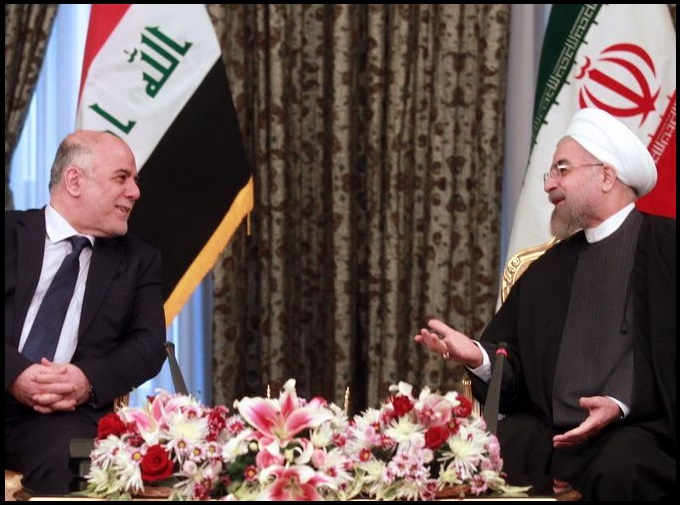
Iraqi Prime Minister Haidar al Abadi and Iranian President Hassan Rouhani in 2014 - Muqtada al Sadr, a popular Shiite cleric, has had a longstanding but occasionally rocky relationship with Tehran. His militia, the Mahdi Army, was supported by Iran; it launched attacks against U.S. troops and Iraqi forces in the 2000s. Sadr fled to Iran in 2007. After returning to Iraq in 2011, he distanced himself from Tehran and rebranded himself as a nationalist. But he didn’t fully sever ties. In 2014, Sadr’s al Ahrar bloc won 34 seats in parliament. In the 2018 elections, Sadr allied with the Iraqi Communist Party to form the nationalist al Sairoon coalition. It won 54 seats, making it the largest bloc in parliament.
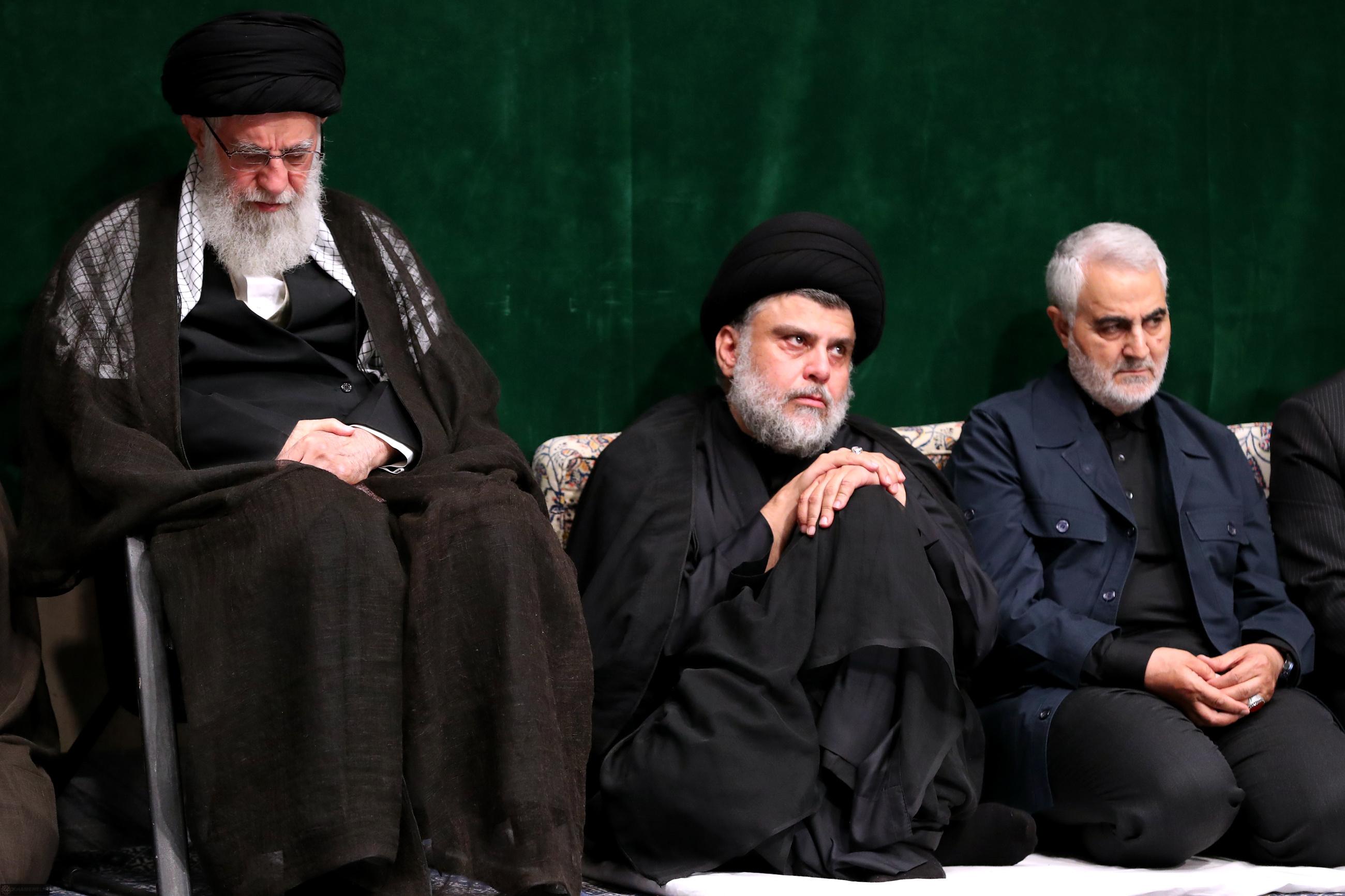
Sadr (center)between Iran's Supreme Leader Ayatollah Ali Khamenei (left) and Qods Force commander Qassem Soleimani (right) at a ceremony in Tehran in 2019
After the May 2018 parliamentary election, political wrangling and rivalries left Iraq without a prime minister for five months. Tehran brokered an end to the deadlock that led to the appointment of Abdul Mahdi, an economist, former oil minister and vice-president.
When the protests erupted on October 1, 2019, Iran continued to support Mahdi. General Qassem Soleimani, the head of Iran’s elite Qods Force, intervened to urge the Fatah Alliance—a political party aligned with the Popular Mobilization Forces, an Iranian-backed Shiite militia—to stand with Mahdi during a no-confidence vote. In mid-November, leaked documents, published by The Intercept and The New York Times, revealed that the Iranian Embassy in Baghdad considered Mahdi to be among several Shiite ministers with a “special relationship” with Tehran.
Iran's Qasem Soleimani & Iraq's Abu Mahdi Muhandis (Iraq's most powerful men) express admiration & respect for one another. These personal relationships go back decades, underpin and are critical to Iran's influence in the region and gives Iran a distinct edge over its rivals. pic.twitter.com/hXiDlwjMW3
— Ranj Alaaldin (@RanjAlaaldin) March 23, 2018
In Tehran, Supreme Leader Khamenei accused protesters of being backed by the United States, Saudi Arabia, and Israel.
I recommend those who care in #Iraq and #Lebanon remedy the insecurity and turmoil created in their countries by the U.S., the Zionist regime, some western countries, and the money of some reactionary countries.
— Khamenei.ir (@khamenei_ir) October 30, 2019
Military
Iran has trained Iraqi militias since the early 1980s, when many Shiite Iraqis sought refuge from rule under Saddam Hussein, a Sunni Muslim. In the mid-2000s, Iran trained and funneled weapons to the Mahdi Army, a militia loyal to Iraqi cleric Muqtada al Sadr. After the 2003 U.S. invasion, the Iranian-backed militias and Iranian weapons—particularly improvised explosive devices, or IEDs, planted in roadside bombs—were linked to the deaths (of hundreds) of American deaths during the U.S. deployment in Iraq between 2003 and 2011.
Iran’s military foothold in Iraq expanded after ISIS swept through Iraq and claimed a third of Iraqi territory in 2014. Iran stepped in with intelligence, arms and strategic planning before any other nation. It was instrumental in the formation of and support to Shiite militiamen in the Popular Mobilization Forces (PMF), an umbrella group of more than sixty predominantly Shiite militias, as well as to Iraq’s military. The PMF was critical in four-year campaign to push ISIS out of Iraq.
Iran’s other militia allies in Iraq have included:
- The Badr Organization, the most powerful Shiite militia, is considered Iran’s oldest proxy in Iraq. Formed in 1982 by Iraqi exiles, it was initially funded, trained, equipped and led by Iran’s Revolutionary Guards. It returned to Iran after Saddam’s ouster in 2003; it continued to have Iranian military support and its political wing also has had close ties with Tehran. Between 2003 and 2011, its militants occasionally attacked U.S. forces. It also waged sectarian war with Sunni rivals. The Badr Organization has fielded at least 10,000 fighters, with some estimates going as high as 50,000.
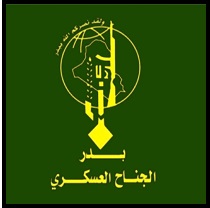
- Kataib Hezbollah, or the Brigades of the Party of God dates back to 2004, when Shiite militants began attacking the U.S.-led coalition. Iran provided weapons, funding and military advice to the group, while Lebanese Hezbollah trained its fighters in Iran. In 2007, five small armed groups united to form Kataib Hezbollah. In 2009, the U.S. State Department designated it as an anti-Western terrorist group with ajihadist ideology and blamed it for terrorist attacks that included use of Iranian-provided IEDs. The Treasury Department sanctioned the group and its leader, Abu Mahdi al Muhandis, which it described as “advisor” to General Soleimani of the Quds Force. In 2011, Kataib Hezbollah was estimated to have 1,000 fighters. By December 2014, it claimed to have 30,000 troops. But a 2016 State Department report estimated its membership was around 400.
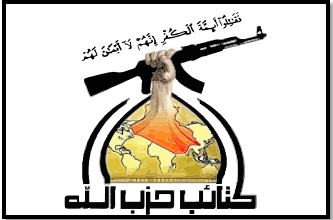
- Asaib Ahl al Haq, or the League of the Righteous, is an Iranian proxy and the third largest Shiite militia in Iraq. It was initially equipped, funded and trained by the IRGC Qods Force, with support from Lebanese Hezbollah, in Iranian camps. Also known as the Khazali Special Groups Network, it has also fought in Syria alongside Lebanese Hezbollah to prop-up the Assad regime. In 2014, Iraqi intelligence reported that Tehran provided the group with up to $2 million a month. The same year, Al Sadiqoon, the groups’ political party, claimed that it had 20,000 members, including its militia.
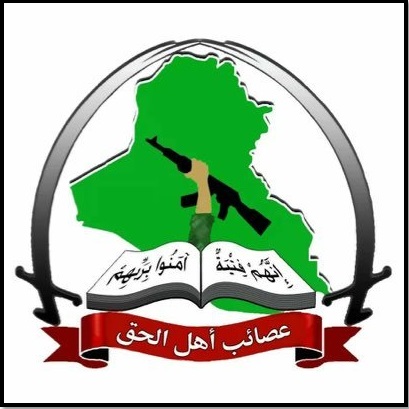
- Harakat Hezbollah al Nujaba, or Movement of the Party of God’s Nobles, is an offshoot of Kataib Hezbollah and Asaib Ahl al Haq formed in 2013. The IRGC Qods Force provided training, arms, military advice, and technical and logistical support to the group. One of its primary goals has been to support the Assad regime in Syria. In 2017, it claimed to have 9,000 fighters divided in three contingents―two in Iraq and one in Syria.
.jpg)
- Kataib Imam Ali, or the Imam Ali Brigades, was established in June 2014. Its members have trained in Iran and with Hezbollah in Lebanon. It has operated primarily in Iraq, but it also dispatched fighters to Syria. In 2014, General Soleimani was on the frontline of the Tikrit offensive against ISIS with Kataib Imam Ali fighters several times.

- Kataib Sayyad al Shuhada, or The Masters of the Martyrs Brigade, is an Iraqi militia established in May 2013 to fight for the Assad regime in Syria. It has been supported and funded by Iran’s Revolutionary Guards since its inception. Similar to Harakat Hezbollah al Nujaba, it expanded operations in Iraq after the rise of the Islamic State in 2014. It worked with the Qods Force and coordinated with other Shiite militias under the PMF umbrella, such as the Badr Organization and Kataib Hezbollah. In 2017, the militia was estimated to have more than 2,000 fighters.
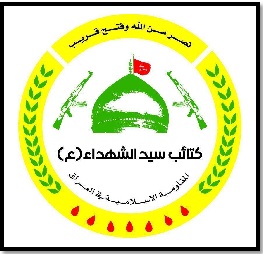
In July 2019, Prime Minister Abdul Mahdi ordered the PMF to integrate into the regular armed forces, which further entrenched Tehran’s influence in Iraq’s armed forces. The decree was only partially enforced, however. Throughout the summer, the PMF was linked to rocket attacks near U.S. military bases. After Israel allegedly struck Shiite militia bases in Iraq, the PMF said it would “defend ourselves and our bases with the weapons at our disposal.” In September, Mahdi rejected calls by the PMF for its own air force. He also removed Abu Mahdi al Muhandis, the deputy head of the PMF, from his post.
After protests demonstrations erupted in Iraq’s Shiite heartland in October, the PMF became the government’s street enforcers. Shiite militiamen opened fire on protesters when they stormed buildings used by the militia in southern Maysan province and Nasiriya, a predominantly Shiite city.
Religion
Iran and Iraq have vied to be the center of Shiite theology since Iran’s Islamic revolution. For centuries, the southern Iraqi city of Najaf has been the most revered Shiite city; it is the burial place of the father of Shiism, Ali ibn Abi Talib, and home to the Imam Ali Mosque. (Shiite is a contraction of Shiat Ali, or Partisan of Ali.) Since 1992, Grand Ayatollah Ali al Sistani, who was born in the Iranian holy city of Mashhad, has been the highest Shiite marja, or most learned Shiite authority, based in Najaf.
Iran’s supreme leader has competed with Sistani for recognition as the ultimate religious authority over the world’s estimated 200 million Shiites. Qom, the Iranian center of Shiite seminaries education north of Tehran, has aggressively sought to gain credibility among the world’s Shiite population. Shiites worldwide are estimated to number around 200 million, or 10 percent to 12 percent of all Muslims.

Iran’s clerics and seminaries both failed to gain superior religious credence or clout. Yet Iran has clout among its brethren in Iraq.
- Millions of Iranian pilgrims throng to Iraq’s Shiite holy sites in Karbala, Najaf and Samarra annually. In the fall of 2019, some 3.5 million Iranians made the pilgrimage to mark Arbaeen in Karbala. The holiday commemorates the end of 40 days of mourning for the martyrdom of Imam Hussein, the son of Ali who was killed during the Battle of Karbala in 680.
- Iran has invested heavily in tourist facilities and infrastructure for pilgrims. In 2014, Soleimani reportedly ordered the construction of a road in Diyala province to shorten the journey for Iranian pilgrims going to the Golden Dome Mosque in Samarra. The Badr Organization supervised the construction. That road and others through Diyala were also helpful in supplying militias fighting ISIS. They also secured Iran’s land connection to Syria and Lebanon.
- None of the four major Shiite clerics in Iraq support the Iranian doctrine of wilayat al faqih, or “the Guardianship of the Jurist” that invests ultimate power in a supreme leader. But they have been split over whether Shiite clerics should speak with legal rather than advisory authority. Grand Ayatollah Bashir supports it and Grand Ayatollah al Fayadh is sympathetic to it.

Sistani has occasionally weighed in during Iraqi political and military crises. His statements have often reflected Shiite interests but also, despite his Iranian origins, reflect Iraqi nationalist interests. (Sistani has lived in Iraq since the 1950s.) In 2014, Sistani issued a fatwa calling on Shiites to mobilize militias to fight ISIS after the Iraqi Army crumbled; it evolved into the PMF.
On November 29, Sistani’s office in Najaf urged the Iraqi parliament to “reconsider” its support for Mahdi, since the government was unable to stop the bloodshed. Mahdi submitted his resignation the same day. His letter acknowledged only the call by Sistani—not the protesters—for a change in leadership. Whoever succeeds Sistani as the marja in Najaf will be able to influence the relationship with Baghdad as well as Qom.
Click here for more information about pro-Iran militias in Iraq.
Garrett Nada is the managing editor of The Iran Primer at the U.S. Institute of Peace.
Andrew Hanna is a research assistant at the U.S. Institute of Peace.
